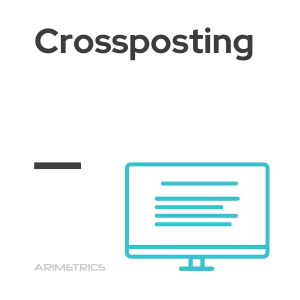 Definition:
Definition:
Crossposting, also known as cross-posting or multiposting, is the practice of posting the same message on multiple social media platforms. This can be done automatically using tools that distribute the content as soon as it is edited.
Origin of Crossposting
The term “crossposting” originated in Internet forums and newsgroups. Originally, if a user wanted to obtain information on a topic, he could post his query in several threads to increase the chances of receiving a response. Today, crossposting has evolved and is used in social networks to extend the reach of a message with minimal effort. This is achieved through crossposting applications, which allow a message to be edited once and distributed across multiple platforms. These tools also allow hashtags, images and scheduled posting of messages to be added.
What Crossposting is for
Crossposting makes it easy to share the same content on different social networks automatically, eliminating the need to do it manually on each platform. This allows a text, image or video to be published simultaneously on multiple social networks. In addition to streamlining a company’s work, crossposting helps to identify messages that have already been sent, thus optimizing content management.
Advantages and disadvantages of Crossposting
Advantages
Among the advantages of crossposting are:
- Time savings: Allows information to be shared efficiently across multiple platforms, which is especially beneficial for businesses.
- Broadening reach: By publishing on various platforms, you ensure that your content reaches a wider audience, adapting to the preferences of users who use different social networks.
Disadvantages
Among the disadvantages of crossposring we can mention:
- Risk of malpractice: Excessive use of crossposting may be perceived negatively.
- Need for customization: Some social networks require content to be customized for their specific platform, which may not be achieved with a uniform cross-publishing approach.
- Negative perception: Loyal followers who follow a brand on multiple networks may view repeated content as negative.
Crossposting Tools
The use of crossposting tools is essential to effectively manage the publication of content on multiple social media platforms. These tools not only facilitate the automatic distribution of posts, but also offer additional functionalities that optimize social media management. Some of the most prominent tools are described below:
- Hootsuite: It is one of the most recognized platforms for social media management. It allows users to schedule and publish content on multiple networks from a single control panel. In its free version, it allows you to manage up to five social media profiles and offers detailed performance analytics. It is especially useful for Twitter, but also supports other platforms such as Facebook, Instagram and LinkedIn.
- Buffer: Another popular tool that simplifies scheduling and publishing content on social networks. The free version of Buffer allows you to manage up to three social media accounts. It offers an analytics function to measure the effectiveness of posts and adjust content strategies accordingly.
- Later: This is a tool specialized in visual content scheduling, especially for Instagram. It offers a visual calendar view that allows you to drag and drop content to schedule it.
- Sprout Social: A comprehensive social media management tool that offers a range of advanced features. It includes post scheduling, social network monitoring, detailed analytics and team collaboration tools.
